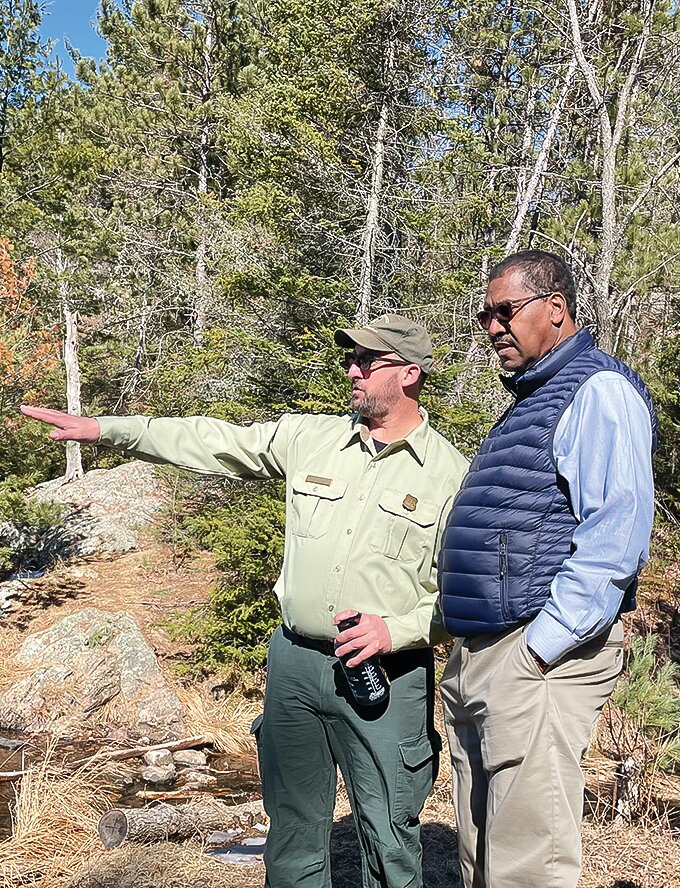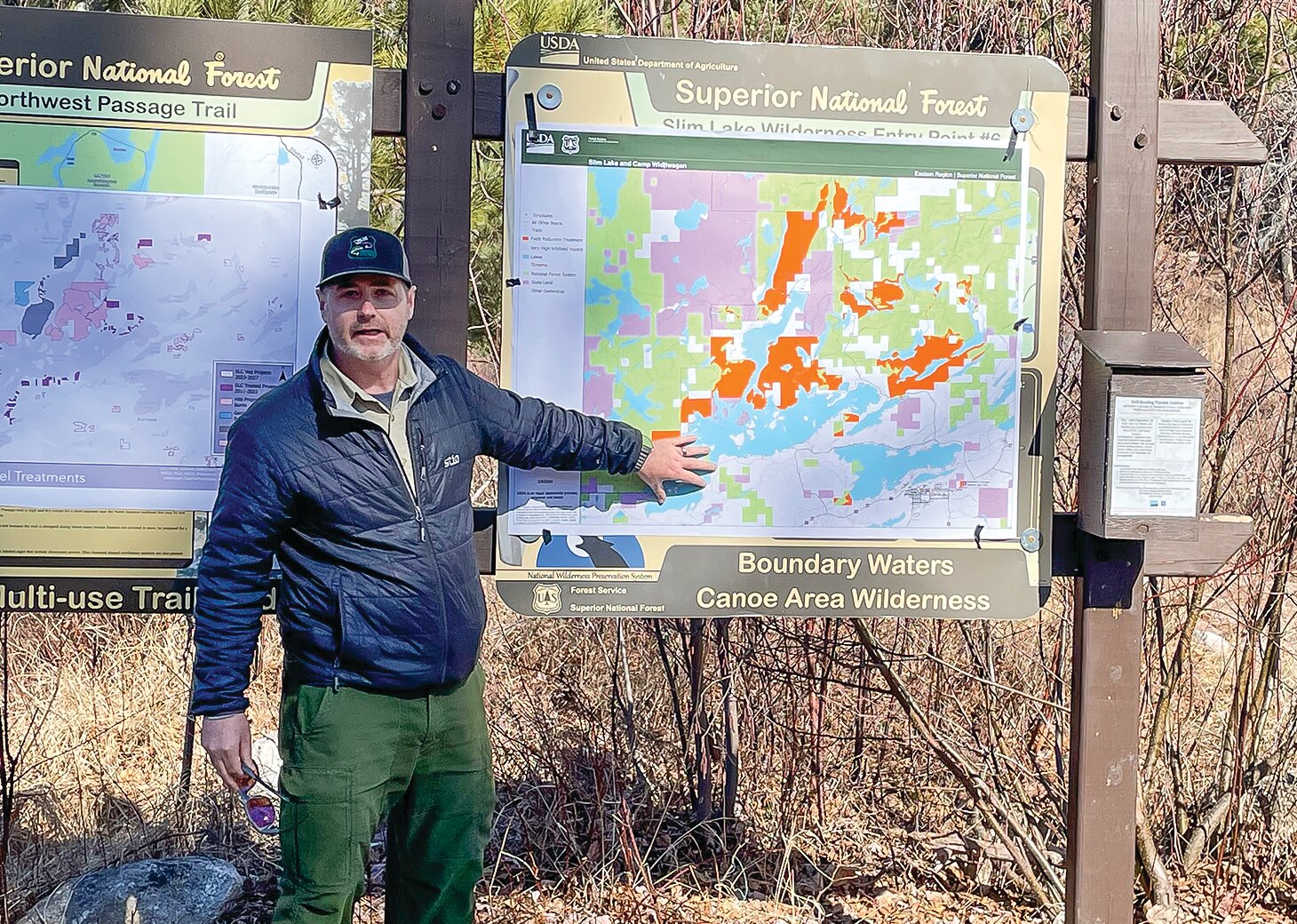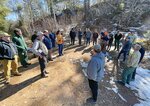Support the Timberjay by making a donation.
Focus on forest fuels
$100 million for fuel reduction and the Superior is high on the list
REGIONAL— Significant federal support could soon begin flowing to northeastern Minnesota to help address the growing danger of wildfire to area communities. And that federal commitment brought …
This item is available in full to subscribers.
Attention subscribers
To continue reading, you will need to either log in to your subscriber account, or purchase a new subscription.
If you are a current print subscriber, you can set up a free website account and connect your subscription to it by clicking here.
If you are a digital subscriber with an active, online-only subscription then you already have an account here. Just reset your password if you've not yet logged in to your account on this new site.
Otherwise, click here to view your options for subscribing.
Please log in to continue |
Focus on forest fuels
$100 million for fuel reduction and the Superior is high on the list
REGIONAL— Significant federal support could soon begin flowing to northeastern Minnesota to help address the growing danger of wildfire to area communities. And that federal commitment brought a high-profile visitor to the region this week, when Dr. Homer Wilkes, the U.S. Department of Agriculture’s Under Secretary for Natural Resources and the Environment toured several hazardous fuels reduction efforts in the region, including a project north of Ely on Tuesday.
Wilkes hardly needed to emphasize the wildfire potential during his visit, which coincided with some of the worst fire conditions ever seen in the region so early in March. At a time when two feet of snow is still typically on the ground, Dr. Wilkes found bare ground, low humidity, and tinder dry conditions, all factors that contribute to high fire danger. And with weeks yet until green-up, fire officials are already on high alert. Per the March report from the National Interagency Fire Center’s predictive services, all of Minnesota currently has significant wildland fire potential.
While most fire reduction efforts at the national level have been focused in the West in recent years, federal officials announced in late February that a $100 million pot of money from the Inflation Reduction Act would go to fund the Collaborative Wildfire Risk Reduction Program, or CWRRP, to bring federal dollars to a total of 24 states, including Minnesota. About half of the qualified states weren’t included in an earlier $400 million allocation to address 21 of the most fire-prone landscapes in the West. Of the latest allocation, Wilkes said the vast majority will go to federal lands in the eastern half of the country and that the Superior National Forest is one of the highest priorities for the funding. Grants under the program can be up to $20 million, so the funding stream could be considerable.
This week’s federal visit was held along the north arm of Burntside Lake and included visits to recent prescribed fires near Slim Lake. Nick Petrack, a fire specialist working on both the Superior and Chippewa national forests, told the nearly three dozen representatives in attendance at the event that few areas are as vulnerable to wildfire impacts as the North Arm Rd. “As you come off the Echo Trail, this is a one way in, one way out road,” said Petrack. He said the road includes several private cabins as well as two YMCA camps tucked in between Burntside Lake and the border of the Boundary Waters Canoe Area Wilderness. “You have upwards of 800 kids at these camps during the summer, so from a fire and emergency response perspective, we need to take care of the fuels that we can.”
Given the mixed ownership throughout much of the Superior, Petrack said effectively dealing with forest fuels requires partnerships with neighboring landowners, from private owners to the state and county. Joe Smith, who manages the Widjiwagan Y Camp, talked about his efforts to address fuel loading in and around the camp, working in conjunction with the Forest Service.
That was a point stressed throughout the day by Wilkes, who said he was impressed by the degree of cooperation and coordination he was seeing in the region when it comes to fire management. “I see a lot of preventive work has been done,” he said. “Folks around this part of the country are proactive, rather than reactive, so we want to try to keep it there.”
Wilkes said the Superior, as the largest national forest in the eastern region, offers a lot opportunities for progress in a region that is prone to some of the largest wildfires in the eastern half of the country. “And then the partnerships are very strong here, so I wanted to come in and see how we bring the two together to leverage a large opportunity.”
Wilkes said the funds, along with other major investments and initiatives already underway in the region, could help the Forest Service significantly reduce fuel loads near developed areas, otherwise known as the wildland-urban interface. While North Arm Rd. has been a top priority, Petrack said the Forest Service would soon be shifting its focus to the other side of Burntside’s north arm, in what it is calling the Hi-Lo project, which encompasses a large area along the Echo Trail, just north of Ely. It’s a roughly 63,000-acre area that is heavily used for outdoor recreation and includes many private inholdings for lake homes and cabins, resorts, and camps.
Tuesday’s event was well attended and included several representatives from the U.S. Forest Service as well as the Minnesota DNR, St. Louis County, and a number of nonprofit groups that have a stake in fuel reduction efforts. A Forest Service fire crew was forced to leave early, however, when the call came in about a grass fire on County Rd. 21, one of the first of what is expected to be a long spring fire season.
Northern Minnesota contains some of the most fire-prone landscapes in the eastern half of the country, particularly on the Canadian Shield, where shallow soils—which dry quickly in drought— and combustible species like jack pine and balsam fir have contributed to a growing number of large-scale fires in the region over the past two decades. Fire officials have noted that past policies of immediate fire suppression along with climate change have greatly increased the incidence and the risk of catastrophic wildfire in the U.S.
According to Superior National Forest spokesperson Joy VanDrie, nearly 200,000 acres on the forest meet the criteria for the federal CWRRP funds, far more than most national forests in the eastern half of the country.
About the program
The Collaborative Wildfire Risk Reduction Program is an effort to promote greater equity in funding distribution from the Inflation Reduction Act. The competitive process is intended to support projects that will significantly reduce wildfire risk with a focus on very high wildfire hazard potential areas and/or high-risk fire sheds in the national forest system.











